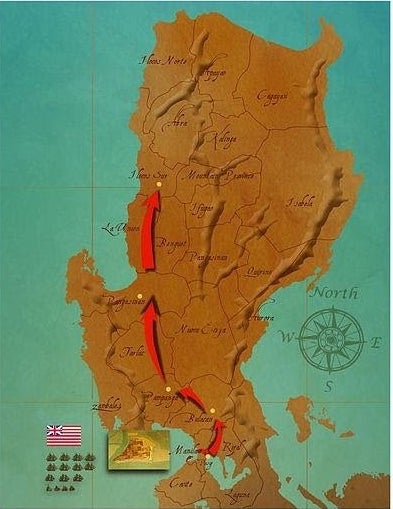British troop movements during the Occupation of Manila (Source: Malacanang.gov.ph)
The Philippines is a diverse country that draws from an eclectic mix of cultures. Much of the Filipino culture and heritage was influenced by trade with China and other Southeast Asian countries, as well as occupation by foreign countries like Spain, America, and Japan. In the Philippines, you can eat Chinese rice noodles, hear Indonesian, Malay, and Spanish words in the same conversation, and ride a jeep that’s been converted into a public bus to visit WWII historical sites. However, most people would be surprised to learn that the Pearl of the Orient was once under the control of the British Empire.
The Seven Years’ War lasted from 1756-1763 (fighting in the Americas started in 1754 with the French and Indian War, but fighting didn’t begin in Europe until 1756). The conflict between the great European powers spanned the globe, making it the first true world war. During this time, the Philippines was a wealthy Spanish colony made famous by its grandeur and the Manila Galleon Trade. Eager to take a piece of this wealth, Britain planned an invasion of Manila with four store ships, three frigates, eight ships of the line, and 10,300 men.
The invasion force sailed from India and anchored in Manila Bay on September 23, 1762. Not expecting the European war to come to the Philippines, the 9,356 Spanish and Filipino defenders were caught off guard. Outnumbered and unprepared, the Spaniards enlisted the help of native Kapampangan warriors to resist the British invasion. The fighting was fierce, with the British firing more than 5,000 bombs and 20,000 cannonballs on the city. Spanish resistance did not last long and a formal surrender ended hostilities on October 6. The greatest Spanish fortress in the Western Pacific capitulated after just two weeks.

The Spanish defeat resulted in the sacking and pillaging of Manila. Houses and buildings were pillaged and burned, people were killed, tortured, and raped, and countless treasures were looted, lost, or destroyed. Not even the churches of the archbishopric in Manila were spared from the violence. To spare the city from further destruction, the British demanded a ransom of four million Mexican silver dollars which acting Governor-General Archbishop Manuel Rojo del Rio y Vieyra agreed to, preventing further loss of life.

With the help of the Kapampangan, Spanish forces retreated from Manila to the Bacolor, Pampanga where they established a new colonial capitol. There, the Spanish organized a resistance to contain the British invasion. An army of over 10,000, most of them natives, was raised for this cause. Although they lacked sufficient modern weapons, resistance forces managed to keep the British confined to Manila and Cavite.
During its occupation of Manila, Britain took advantage of its location to increase trade with China. The British were unable to capitalize further on their conquest, since the Seven Years’ War ended with the Treaty of Paris on February 10, 1763. That said, news of the peace agreement did not reach the Philippines until early 1764. The British ended their occupation, departing Manila and Cavite, in the first week of April 1764.
Over a century later, the Filipino nationalist and vocal opponent of Spanish occupation, Jose Rizal, lived in London from May 1888 to March 1889. He was astounded to find Filipino artifacts in the British Museum. Among the cultural treasures were the Boxer Codex (c. 1590) and a rare copy of Antonio de Morga’s Sucesos de las Islas Filipinas (1609). According to Kirby Araullo, author and co-founder of the Busolan Center for Filipino Studies, the two artifacts are among the most important primary sources of early Philippine history.
The Spanish defeat was also a turning point for the Spanish Empire; it showed that Spain was no longer the dominant world power that it once was. The Spanish vulnerability emboldened many uprisings against Spanish occupation, including an ill-fated revolt by the national hero couple, Diego and Gabriela Silang. The Sultan of Sulu, a former Islamic state that controlled islands in the present-day southern Philippine Islands and north-eastern Borneo, was also freed from Spanish imprisonment during British occupation. He aligned with the British against the Spanish and increased pirate raids by the Sultanate of Sulu against Spanish colonies.
The Battle of Manila was a major military, political, and financial blow to the Spanish Empire. Although the British were unable to carry out a full conquest of the islands, the Spanish defeat was the catalyst for continued Filipino uprisings and resistance to Spanish occupation.


